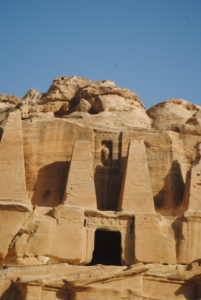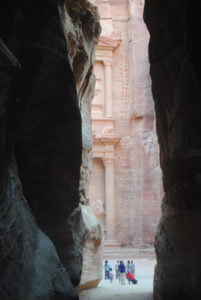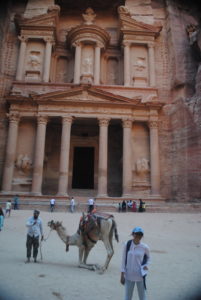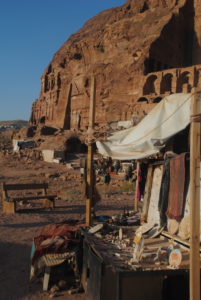One of the highlights of my journey to Jordan was my trip to Petra.
Petra is a ruined city hidden away in a valley just three hours away from Amman. Much like the Citadel of Amman, this ruin has a rich history encompassing Arab, Roman and Ottoman periods and is quite literally a city of the dead.
The ruins of Petra are composed firstly of graves and tombs carved into the sandstone mountains of Petra. These ornate tombs were meant to be the springboard for rich individuals so they could arrive in the afterlife with style. The graves range from simple hollowed out caves to ornate mini-palaces with statues carved into the rock. Thousands of slaves had to have been employed to build these house-sized graves over the course of centuries.
It is amazing to me that these ancient Nabateans spent so much of their wealth and energy in preparation for their death. Seeing an entire city that the people of Petra made to forge their tombs and glorify their dead is simply awe-inspiring. In a way, this belief system is not entirely dissimilar to that of Islam, for Muslims are also taught to spend their life here preparing for the life that comes after (although of course Muslims are told to do that preparing by doing good deeds, rather than constructing elaborate tombs).
In any case, the largest structure that seems to be intact is the Treasury (Al-Khazneh) in the heart of Petra. It is a massive structure in the heart of a huge valley in the middle of the dead city. We traveled there when we first arrived and it is absolutely huge building with Greek gods and goddesses depicted alongside it. On the way there, aqueducts were carved into the mountainside, which the ancient inhabitants of this land used to keep themselves supplied with water constantly. This treasury was the entry point into this mysterious city and showed how the people that lived here wanted everyone who visited to know of their opulence and might of their city.
Later, we climbed up a mountain path called the ‘thousand steps’ to reach the Monastery top of Petra (El-Deir). This name turned out to be somewhat inaccurate, as the ‘steps’ were so badly eroded and cracked that they were hardly steps at all, and I am pretty certain that there were far more than a thousand. Exhausted, we eventually had to ask some Bedouins for a donkey ride in order to get all the way up the towering mountain. The Monks that once maintained the monastery up there must have been quite reclusive indeed if this was the only way for a visitor to reach them.
Atop the mountain, we found that unfortunately most of the Monastery was either ruined or closed off to the public. In this case, the journey became more important than the destination. A reminder that our focus in life is supposed to be on the ‘learning process’ and not on the ‘result’.
Still, climbing this historical marvel and looking down at this vast city of the dead (and Petra truly is huge – a real city of tombs and graves) was magnificent, though afterwards my legs felt like blocks of wood. Hiking in a desert is much more difficult than hiking in Indonesia or out in America. The oppressive heat rapidly drains your energy and even if you have a constant supply of water you will soon feel quite exhausted.
A visitor like me thus can’t but feel a sense of wonder when seeing the Bedouin, who live in makeshift tents throughout the path going up the hill underneath the sweltering heat. Like their ancestors from Petra, these Bedouin live in the desert with a certain joy and seem to take pleasure in galloping back and forth across the desert paths that mark the dead city, sometimes even happily living and sleeping inside of the looted tomes.
My trip to Petra was thus one of my most memorable moments in Jordan, for it showed me a unique window into how religions and traditions can shape entire civilizations.



